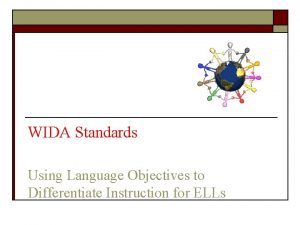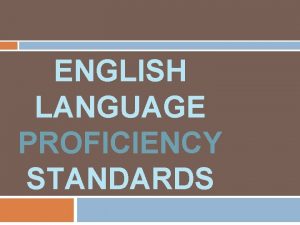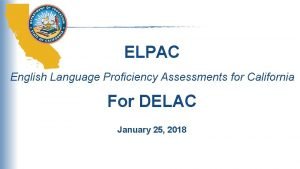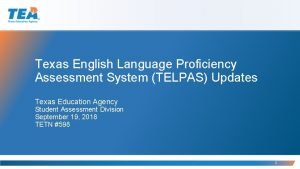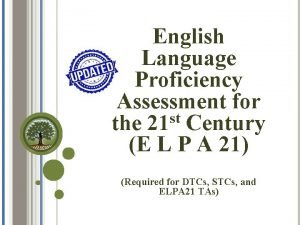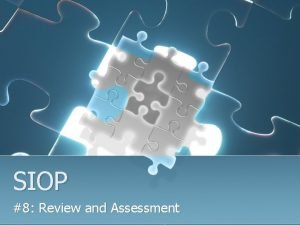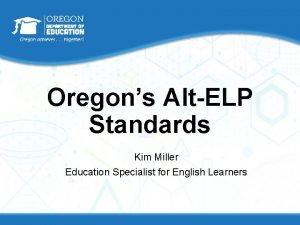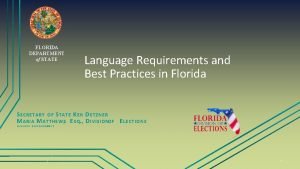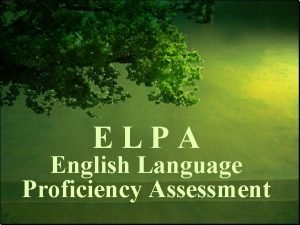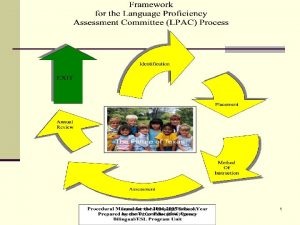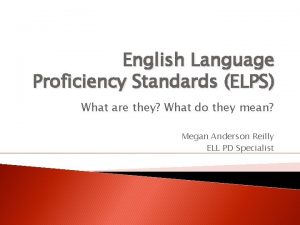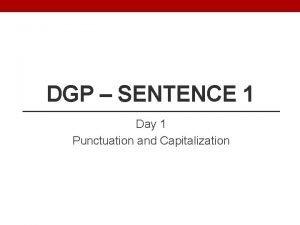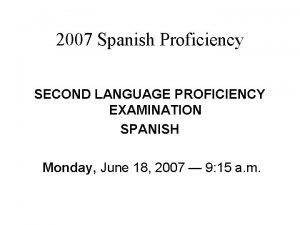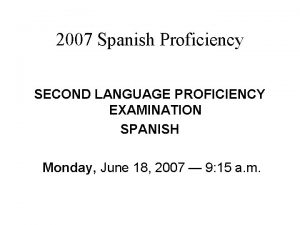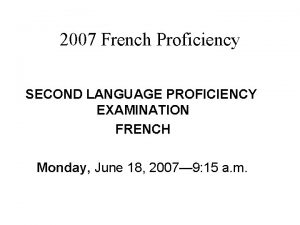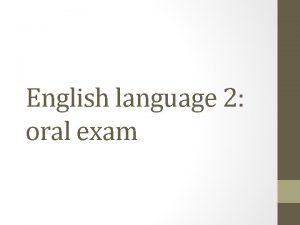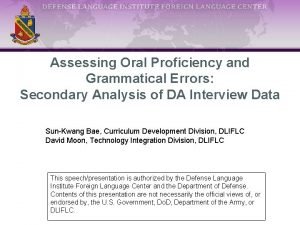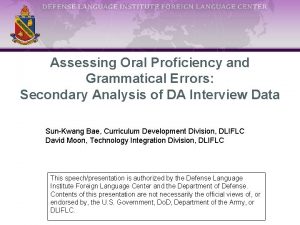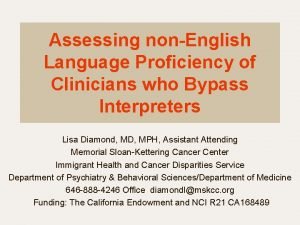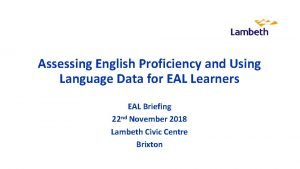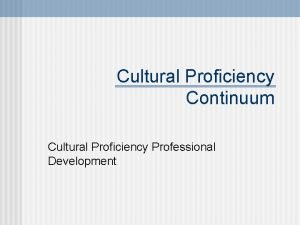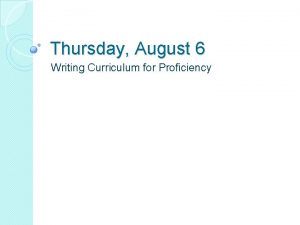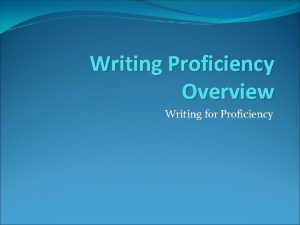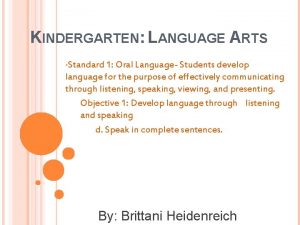Assessing Oral Language Proficiency in our students Learning

























- Slides: 25

Assessing Oral Language Proficiency in our students Learning about speaking tests

The Lighter Side….

What’s on tap? n What are the principles of good test design? n Practice making test rubrics and assessing. n Learn how to deliver and design a “retelling” speaking test AND a level placement test.

What do you believe…. ? We give tests so that …………. . Tests provide teachers with …………. . When testing in my class, I usually …………. . Tests help students …………. . A good speaking test should …………. . All tests must …………. . My opinion on tests is …………. . An example of one kind of test is …………. .

The Alphabet Soup of Assessment

Background: The Purpose of Tests Andrew Finch, Kyungpook Nat. Univ. of Education , Daegu, S. Korea

Basics 1 – Making a rubric What is a rubric? "a scoring tool that lists the criteria for a piece of work or 'what counts. ' " -- Heidi Goodrich

Complete the Following…. . n The purpose of testing is…. n Tests can easily become …. n Classroom based tests should ……… n Also, they should ……….

Complete the Following…. . n The purpose of testing is…. To give information to the students and teachers (also parents!)

Complete the Following…. . Tests can easily become …. Normative and Comparative. (but should be Criterion based and about what the student CAN do)

Complete the following Classroom based tests should ……… - Non – threatening environment - Focus on “real situations” and the process of learning.

Complete the Following…. . Also, they should ………. Provide big picture. Emphasize thinking skills and collaboration. provide information and be about the learning.

THE GOLDEN RULE! Test what the student CAN do NOT What the student can’t!

What does speaking consist of? e Flu ncy Vo ca bu lar y Successful. mp Students o in k gs r ma L en ist am Gr ill C s/ on ciati n u n o Pr

Fill in the rubric with descriptors Fluency Limited some Pronunciation unclear Parts clear Vocabulary limited adequate Effort poor fair good Mostly clear Well Developed Very clear sound extensive Good excellent

Assessing through an Interview n Students know the questions and have practiced. n Design the rubric. n Select 4 questions to ask a student. n Score the student based on their response.

Oral Assessment using retelling Retelling is a powerful way to fully assess a student’s ability to produce language. It shows with validity that a student understands the language used and most importantly, can use it. ___________________ 1. List the main ideas of the story. 2. Design a rubric or storytelling checklist. 3. Ask the student(s) to retell the story. 4. Check all ideas that the student successfully retells/relates. 5. Total the score.

Checklist Major Ideas: Heungbu / Nolbu Two brothers, one poor , one rich. Heungbu asks for food. Nolbu refuses. A swallow comes. Heungbu helps. Gets a seed. 3 gourds grow. Treasure comes out. Nolbu is jealous. Does the same. Monsters come out. Heungbu helps Nolbu changes. They live happily. Score 1 2 3

Oral Assessment using “sequencing” – HOW TO……. 1. 2. 3. 4. 5. Explaining “how to” do something is an excellent way to assess student speaking ability. ________________ List the main steps. Teach / practice. Design a checklist. Ask the student(s) to explain “how to. . . ” Check all steps that the student successfully retells/relates. Total the score.

Checklist Steps: How to make a P&J sandwich Get two slices of bread. Put peanut butter on one. Put jelly on top of the peanut butter. Cut the sandwich in half. Eat the sandwich! 1 2 3

Beware of “narrow” testing

Be Careful! § Assure all students understand the criteria of assessment (the rubric) Pre Test § Did you teach enough, the required content? § Check for “Silent Period” During Testing § Provide a proper environment / warm up. § Test what you taught! § Give students specific feedback Flood & Lapp, 1992 After Testing § allow for a retake. Praise!

Placement Testing A great Picture Key Vocabulary Character 1: Questions in increasing difficulty Vocabulary Rank Character 2:

Websites to help test speaking Teacher Evaluation

“one teaches, two learn. ” ddeubel@gmail. com http: //eflclassroom. ning. com
 Group discussion is a modern method of assessing
Group discussion is a modern method of assessing Thinking language and intelligence
Thinking language and intelligence Wida language objectives examples
Wida language objectives examples Language proficiency levels
Language proficiency levels Language
Language Elpac scores meaning
Elpac scores meaning Telpas calibration rubric
Telpas calibration rubric English language proficiency assessment (elpa)
English language proficiency assessment (elpa) Lpac student history worksheet
Lpac student history worksheet Review and assessment siop
Review and assessment siop Language proficiency
Language proficiency Language english proficiency
Language english proficiency Oelpa standards
Oelpa standards Elpa test
Elpa test Language proficiency
Language proficiency Lpac framework
Lpac framework What are the elps
What are the elps Oelpa
Oelpa Rizal participated in the student demonstration in madrid.
Rizal participated in the student demonstration in madrid. Cuadro comparativo entre e-learning b-learning y m-learning
Cuadro comparativo entre e-learning b-learning y m-learning Many students work on the star our school newspaper
Many students work on the star our school newspaper Our census our future
Our census our future Christ be our light shine in our hearts
Christ be our light shine in our hearts Our life is what our thoughts make it
Our life is what our thoughts make it We bow our hearts
We bow our hearts Our census our future
Our census our future


